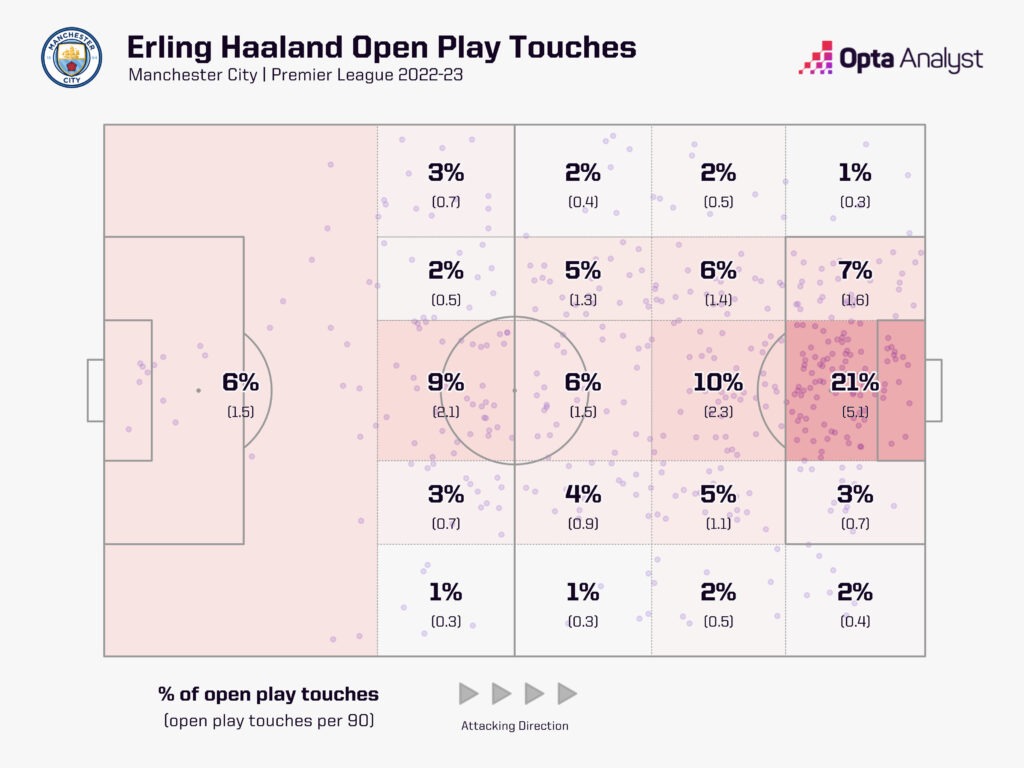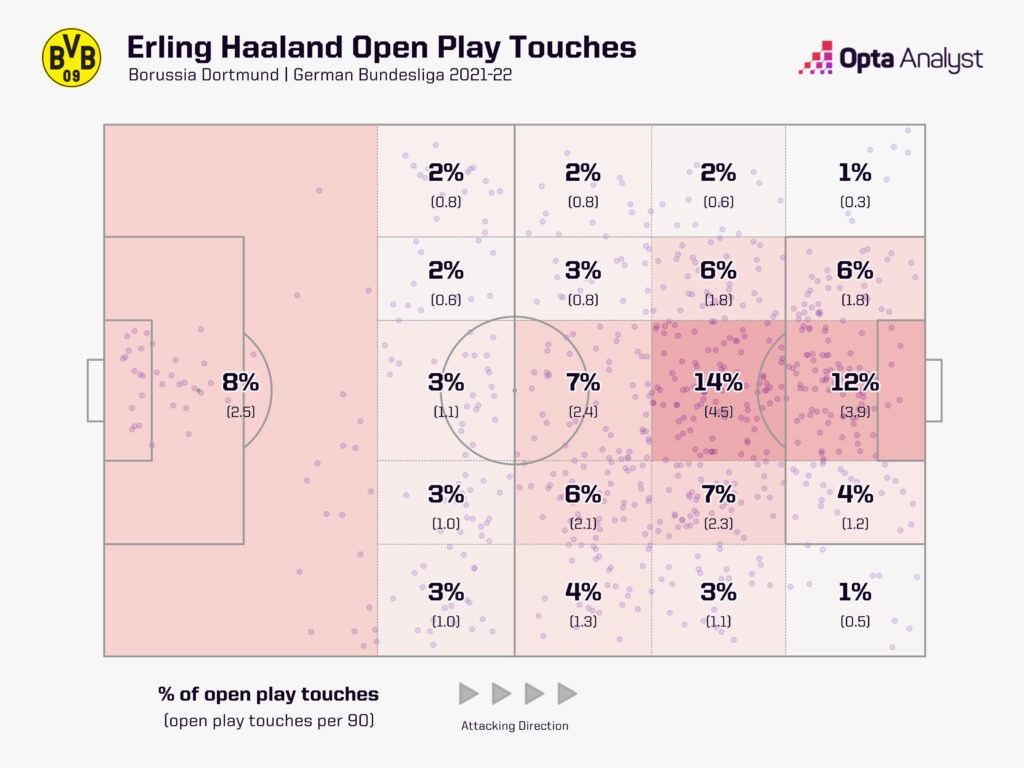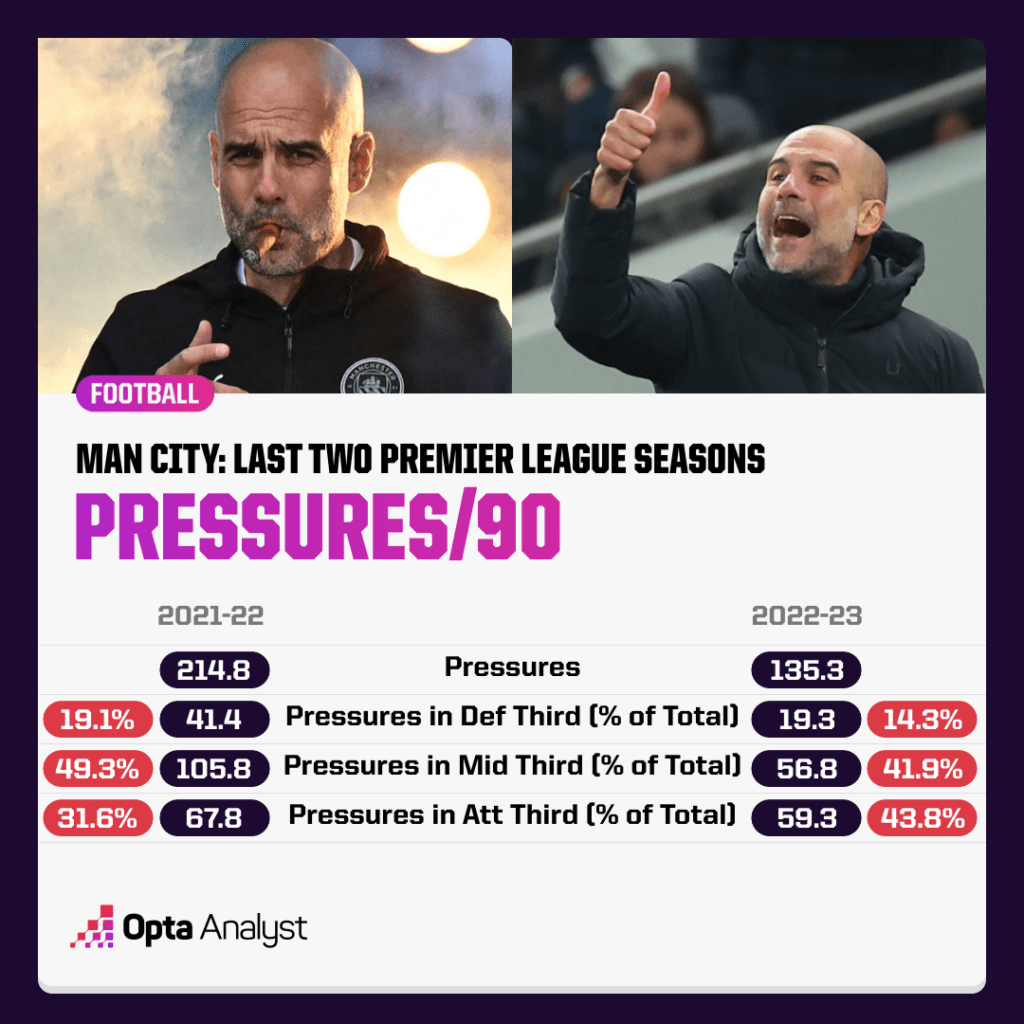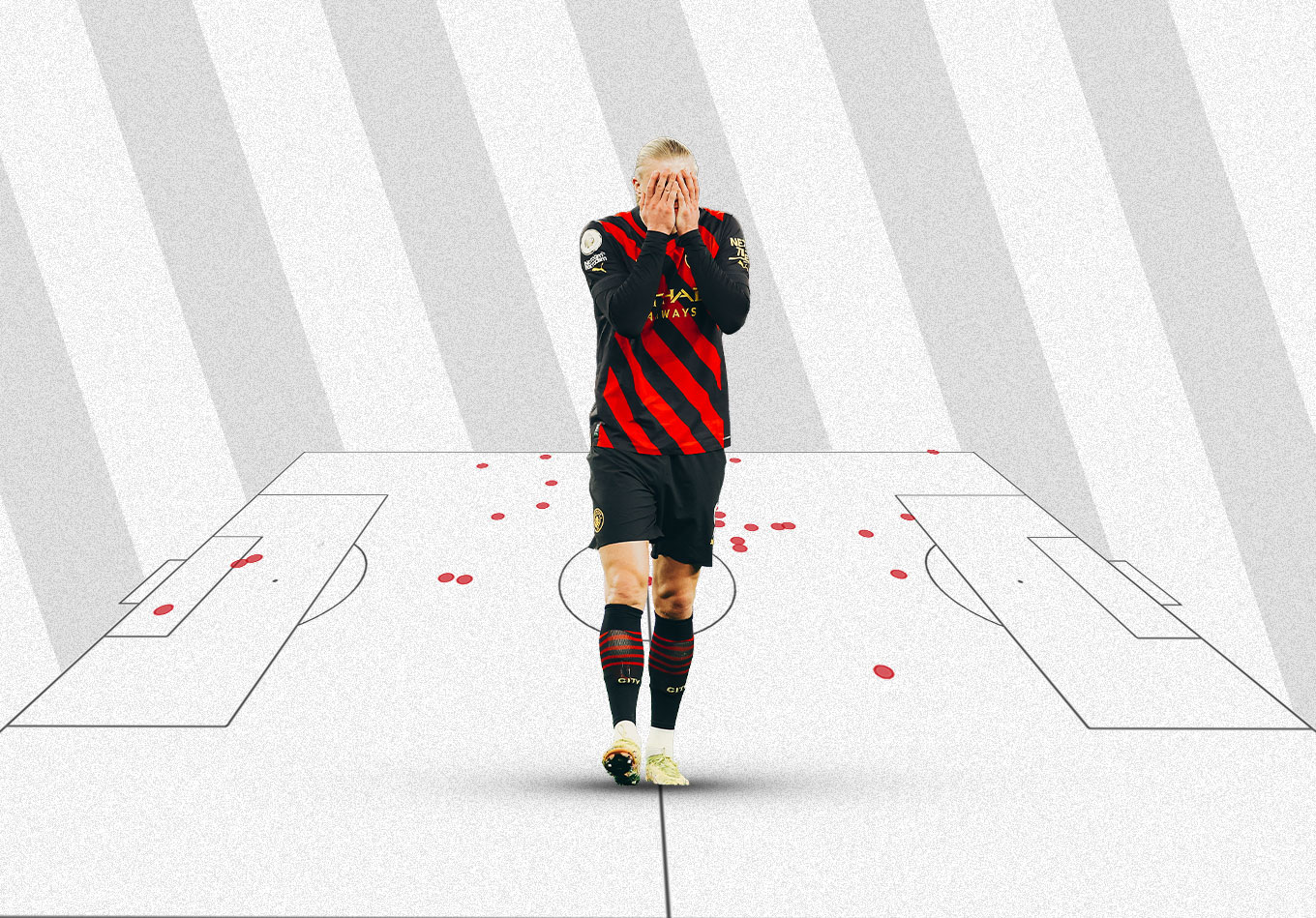Right, it’s time. It’s time to utter those words we were afraid to say (but sort of suspected all along) for fear of being ridiculed: As good as Erling Haaland is, there’s a strong argument that he’s made Manchester City worse as a team.
Not enough was made of the extraordinary tactical gamble that Pep Guardiola took last summer when he signed a man whose straight-lined approach is an act of defiance against the very principles of Man City.
Plonking a transition-centric penalty-box striker into a false-nine-loving team of possession domination was always going to require something radical. So far, both player and team are weaker than they were last season and Guardiola, by his standards, is in tactical crisis.
Haaland’s Numbers and his Shifting Role
The goals are flowing, but that does not automatically mean Haaland is adding value. His 1.37 goals-per-game average eclipses anything he achieved at Borussia Dortmund, RB Salzburg, or Molde but Man City are scoring no better, recording the same tally (53 after 21 Premier League games) as last campaign. So, we cannot simply take his goals in isolation and call Haaland a success.
It was assumed Haaland would adapt to City’s tactical style, but surprisingly he is even less involved outside the box at City than he was at Dortmund. Comparing this season to last, his attempted passes per game is down from 11.7 to 15.6, his average number of touches is down from 33.1 to 24.2, and his progressive carries per game are down by almost half, from 1.89 to 1.04.
He is doing less – and in a smaller area, too. A remarkable 21% of his touches are in the central area of the opposition box, which is almost double the 12% he recorded at Dortmund last season and a scarcely believable increase on the highest percentage recorded by a Man City player last season. Raheem Sterling and Gabriel Jesus were joint first, with 5%.


That final shift, Haaland’s 12% to the previous high of 5%, shows just how different it feels to have the Norwegian up front compared to one of Guardiola’s false nines. Understandably, it has caused a headache – and led to a dramatic change in how the Man City manager sets his team up to play, with (so far) negative consequences on their attacking and defensive strategies.
Man City Lose their Speed and Verticality
Starting with the attacking side of things, Guardiola decided that the introduction of a rapid line-breaking striker in the middle meant sacrificing this option from the flanks. The sale of Sterling to Chelsea in the summer left him without an urgent, bustling, make-things-happen energy on the wing for the first time in his managerial career. From David Villa to Arjen Robben to Leroy Sane to Sterling, his teams have always needed that quality out wide.
Guardiola hates being accused of playing ‘tiki-taka’, yet by withdrawing penetration from the wide areas Man City have begun to sink towards the slow and rhythmic possession recycling he has always rejected. His tactics require an element that rubs up against the meticulous passing structures to offer a sudden, tearing point of difference, but with Jack Grealish and Riyad Mahrez either side of Haaland, this has been lost. With it has gone the driving run to the byline for a pull-back, or the option for a switch of play that catches out a defensive shell dragged over to one side. Also out the window is City’s unpredictability, leaving instead a host of between-the-lines playmakers dancing around a static Haaland, all of them facing an opposition blockade.
The difference is subtle, of course. On many metrics Man City are performing just as well as last season and, most of the time, they get the job done. But when faced with a low block they miss those piercing wingers and Haaland, crowded out, cannot make up the difference in a congested penalty area.
The numbers back this up. Man City’s sprints per game are down from 130.1 last season to 120.4 in 2022-23, while their progressive carries per 90 are down from 30.1 to 20.5 – a 33% drop. Their number of take-ons per game is also down, from 19.5 to 16.9, while their carries into the penalty area have dipped by 30% from 10.2 to 7.6 per 90.
Haaland’s presence is a double whammy in this regard. Not only is he slowing City down and therefore allowing opponents to sit deeper without fear of being prised apart, but his very reputation on the shoulder of the last defender encourages fearful teams to retreat into a lower block. A vicious cycle is created, and City end up passing and moving slowly with 11 bodies in front of them. No wonder their crossing has increased from 16.0 to 21.5 per match. No wonder even Manchester United and Liverpool concede territory at home against Man City, recording 29% and 37% possession respectively in the Premier League.
Opposition Counters on the Rise
The emerging constipation in Man City’s attack wouldn’t be a problem if their defence was as good as last season. But it isn’t. They are averaging 1.0 goals per game against, up from 0.68 in 2021-22, and again that can be attributed at least partly to Haaland’s appearance in the starting XI.
It all comes down to Man City’s counter-press (the pressure they apply after losing the ball) and its waning effectiveness, because once the first wave of pressing has been bypassed opponents generally find it easy to counter-attack into wide open spaces against City’s high-line. That is always the risk of such bold and expressive football, but whereas historically Guardiola has judged it right, this season the initial counter-press is letting him down.
The issue is twofold. First, although Haaland is no slouch he presses almost exclusively high up the pitch, hence why he tops the Premier League charts for pressures in the final third, with 256. Never being in the position that a false nine would be in means never helping the midfield line should the ball be lost here, and that crucial – though slight – positional shift explains Man City’s pressing statistics.
To summarise the table below, Man City’s number of pressures has decreased considerably this season, reflecting a weakening counter-press and increased opposition breakaways, while the weighting of these in the three thirds has changed markedly. This season, 43.8% of their pressures are in the final third, compared to just 31.6% the year before: the middle third, one man lighter, is now a more vulnerable area.

There is a second, perhaps more important, reason for these numbers. In an attempt to counteract Haaland’s lack of movement into deeper areas of the field Guardiola has increasingly instructed his midfield players to move higher to give him close support, which in turn is emptying out that central midfield area. This (again, subtle) movement is best highlighted in Guardiola’s changing preferences in personnel: the more cautious Ilkay Gundogan and Kalvin Phillips have struggled for minutes, even allowing for injuries, while recently forward Julián Álvarez has been drafted in as an attacking midfielder.
The impact of this weakening counter-press is borne out in the numbers. City’s PPDA has risen from 10.3 to 11.7 this season and their field tilt is down from 79.7% to 75.2%. Their number of progressive passes allowed per 90 has risen from 19.9 to 22.2, as has the progressive carries allowed, from 10.3 to 11.4. Looking at less advanced data, their through balls allowed has almost doubled, from 0.76 to 1.32, while their total shots allowed is up from 6.2 to 7.5.
How Does Guardiola Fix It?
A theme developing at Man City is Guardiola throwing good money after bad: doubling down on his Haaland gamble and digging himself a hole. Selling Sterling, Gabriel Jesus, and João Cancelo – all, to varying degrees, because they go against the tactical grain and therefore don’t fit with the New Haaland Order – has stripped Man City of options to try new things.
Most recently, it left Guardiola having to play 18-year-old right-back Rico Lewis as a hybrid left-back/central midfielder in a tricky game at Tottenham Hotspur. Nobody should blame the teenager for getting caught between the two roles and allowing Emerson Royal and Dejan Kulusevski to dominate that area on the break. Cancelo or Oleksandr Zinchenko would have stopped them.
The Spurs defeat was weird for all sorts of reasons. The new 3-2-4-1 formation doesn’t make a lot of sense (being too narrow, it jams up the middle, further isolating Haaland centrally and leaves opponents to double up on the lonely-looking Grealish and Mahrez) and has even led to the temporary dropping of Kevin de Bruyne. The Belgian isn’t looking himself at the moment, struggling – more than most – to playing without space in front of him. De Bruyne craves the open patches of grass that came from City being able to move quickly and vertically, rather than the ponderous possession we have seen of late.
Things aren’t looking too good for a quick return to form, then, although perhaps all that’s needed is time. Guardiola is no doubt training Haaland day and night to adapt to the team and, just maybe, the Man City manager will even feel able to loosen the reins a little – and adapt to Haaland.
4 – In the Premier League, Erling Haaland’s four lowest game totals for off-ball runs targeted by a teammate have all come in his last four appearances.
— OptaJoe (@OptaJoe) February 6, 2023
6 v Man Utd (A)
6 v Spurs (H)
4 v Wolves (H)
5 v Spurs (A)
Solitary. https://t.co/jN4ueCmpgq pic.twitter.com/VaJueFXMa0
It is striking how often Haaland makes clever runs but is not found. Even more striking is what the data says: Man City’s number of direct attacks (1.7 per game) has not changed this season and their high turnovers are scarcely different (9.9 per game last year, 10.5 this year), yet they have already scored more goals from direct attacks (three) than they did in the whole of last season (two) and scored almost as many from high turnovers (five) as in the entirety of 2021-22 (six).
In other words, when Man City move faster – counter-attacking and moving directly up-field – their Haaland-led attack is brilliant. We’ve seen an awful lot of column inches dedicated to how Haaland needs to adapt to Guardiola. Why not try the other way round?
Enjoy this? Subscribe to our newsletter to receive five stories each Friday. It’s free. Also, follow us on Twitter.
